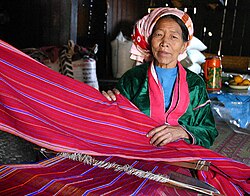Ta'ang people

A Ta'ang tribal woman near Kalaw, Shan State, Burma.
|
|
| Total population | |
|---|---|
| (557,000 (est.)) | |
| Regions with significant populations | |
| Burma, smaller populations in China: Yunnan, Thailand | |
| Languages | |
| Ta'ang | |
| Religion | |
| Theravada Buddhism |
The Palaung (Burmese: ပလောင် လူမျိုး [pəlàʊɴ lùmjó]; Thai: ปะหล่อง, also written as Benglong Palong) or Ta'ang are a Mon–Khmer ethnic minority found in Shan State of Burma, Yunnan Province of China and Northern Thailand. In China, they are referred to as the De'ang (Chinese: ; pinyin: Déáng Zú also spelt Deang) people.
They live mainly in the northern parts of Shan State in the Pa Laung Self-Administered Zone, with the capital at Namhsan.
The Ta'ang (Palaung) State Liberation Army, the armed wing of the Palaung ethnic group, began fighting against the Burmese military in 1963. It entered a cease-fire agreement with the central government in April 1991, but is currently continuing the insurgency. Both the government and the rebel armies have derived benefit from poppy cultivation, which has caused serious drug addiction among the local people.
There are three main subgroups of Ta'ang: the Palé, Shwe and Rumai.
The Chinese government groups together the Palé, Riang, Rumai and Shwe peoples as the De'ang ethnic nationality. The group also includes the Danau (Danaw) who may no longer have a separate identity from the Palé.
There are three principal Palaung languages.
In China, the De'ang are found in the following villages of Zhenkang County and Gengma County. In China, they are known as the Laopulao 牢普劳; there are 6 other De'ang groups located in Burma.
Most Ta'ang are adherents of Theravada Buddhism and Buddhist temples can be found in most of their towns. Buddhism is present in all of the daily activities of this ethnic group. At the age of 10, many children are sent to the monasteries, primarily for education. Most of them return to lay life in later years.
...
Wikipedia
